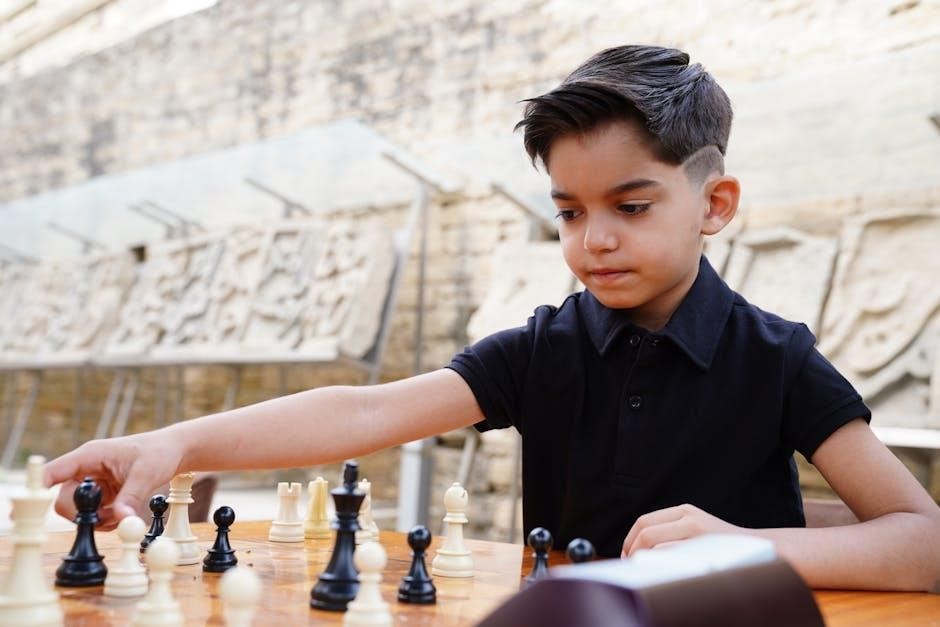The Whole-Brain Child by Daniel J. Siegel and Tina Payne Bryson offers a groundbreaking approach to understanding and nurturing a child’s developing mind. This insightful guide provides 12 revolutionary strategies to help parents and caregivers foster emotional balance, resilience, and strong relationships, ensuring children thrive in all aspects of life.
1.1 Overview of the Book
The Whole-Brain Child by Daniel J. Siegel and Tina Payne Bryson is a transformative guide that explores the science of child brain development. Published in 2012, this book offers 12 innovative strategies to help parents navigate emotional challenges and foster resilience. By explaining concepts like the “upstairs” and “downstairs” brain, Siegel and Bryson empower caregivers to understand how a child’s mind matures. The book is available in PDF format and has become a trusted resource for parents seeking practical, science-backed solutions to raise balanced, emotionally intelligent children.
1.2 Authors: Daniel J. Siegel and Tina Payne Bryson
Daniel J. Siegel, a renowned neuropsychiatrist, and Tina Payne Bryson, a parenting expert, collaborated to create The Whole-Brain Child. Siegel’s expertise in brain science and Bryson’s practical parenting insights blend seamlessly, offering a comprehensive approach to child development. Their combined knowledge provides strategies that are both scientifically grounded and easy to implement, making them trusted authorities in the field of parenting and child development. Their work has resonated globally, helping parents nurture their children’s emotional and mental growth effectively.
1.3 Key Concepts and Objectives
The Whole-Brain Child focuses on helping parents understand how their child’s brain develops and functions. It introduces the concept of integration, which is key to emotional regulation and resilience. The book aims to equip parents with practical strategies to connect with their child’s emotions, reduce conflicts, and encourage cooperation. By teaching parents to “speak” to their child’s brain, the book helps foster emotional intelligence, self-control, and a stronger parent-child relationship, preparing children for long-term emotional and mental well-being.

Understanding the Developing Brain
The Whole-Brain Child explores how the brain develops, emphasizing the interplay between emotional and logical thinking. It highlights how understanding brain structure and function helps parents guide their child’s emotional and cognitive growth effectively.
2.1 The “Upstairs Brain” and “Downstairs Brain”
The “Upstairs Brain” represents higher-order thinking, including logic and decision-making, while the “Downstairs Brain” manages emotions and instincts. The book explains how these two systems develop at different rates in children. The Upstairs Brain matures slowly, requiring guidance, while the Downstairs Brain reacts impulsively. Understanding this distinction helps parents respond to meltdowns more effectively by teaching children to integrate both systems for emotional balance and rational thinking. This concept is central to fostering self-regulation and resilience in kids.
2.2 The Role of the Prefrontal Cortex
The prefrontal cortex, part of the “Upstairs Brain,” plays a crucial role in decision-making, planning, and regulating impulses. In children, this area is still maturing, often leading to impulsive behaviors. When overwhelmed, the prefrontal cortex can “go offline,” causing emotional outbursts. Parents can help strengthen this region by modeling calm, focused behavior and teaching strategies to manage emotions. A well-developed prefrontal cortex fosters self-control, problem-solving, and better decision-making skills in children, laying the foundation for long-term emotional and cognitive health.
2.3 The Interaction Between Left and Right Hemispheres
The left and right hemispheres of the brain specialize in different functions but work together for optimal development. The left hemisphere excels at logic, language, and detail-oriented tasks, while the right handles emotions, intuition, and spatial awareness. When integrated, they enhance problem-solving, creativity, and emotional regulation. Helping children develop this integration involves activities that engage both hemispheres, fostering a balanced and harmonious brain. This synergy supports healthier emotional and cognitive functioning, enabling children to navigate challenges more effectively.

The 12 Revolutionary Strategies
The book introduces 12 innovative, science-backed strategies to help parents guide their children’s brain development, focusing on emotional regulation, communication, and fostering essential life skills.
3.1 Connect and Calm: Strategies for Emotional Regulation
This strategy emphasizes the importance of helping children regulate their emotions by connecting with them on an emotional level. Parents are encouraged to use empathy, physical comfort, and soothing words to calm their child’s emotional storms. By doing so, they help activate the child’s “upstairs brain,” reducing stress hormones and fostering a sense of safety; This approach not only de-escalates tantrums but also teaches children how to manage their emotions, leading to healthier emotional and social development over time.
3.2 Name It to Tame It: Labeling Emotions
This strategy focuses on helping children recognize and label their emotions, which can reduce emotional intensity. By naming feelings, parents help their child process and manage emotions more effectively. This approach encourages emotional awareness and regulation, teaching children to articulate their feelings instead of acting them out. It fosters self-control and resilience, aiding in healthier emotional development.
3.3 Engage, Don’t Enrage: Encouraging Cooperation
This strategy emphasizes the importance of engaging children in a way that fosters cooperation rather than triggering resistance; By involving them in decision-making and offering choices, parents can encourage a sense of control and participation. Using a calm and respectful tone helps prevent anger and promotes a collaborative environment. This approach teaches children to take responsibility and work together, enhancing their willingness to cooperate without feeling forced or dictated to.
3.4 Use It, Don’t Lose It: Practicing Life Skills
This strategy encourages children to practice essential life skills actively. By providing opportunities to apply what they’ve learned, parents help strengthen neural pathways. For example, guiding children to solve problems or manage emotions themselves fosters independence. Regular practice of these skills ensures they become second nature, equipping children with the tools they need for future challenges. This approach emphasizes hands-on learning over passive instruction, promoting long-term retention and confidence.
3.5 Teach, Don’t Tell: Guiding Through Experiences
This strategy emphasizes guiding children through experiences rather than simply instructing them. By engaging their minds and emotions, parents help kids understand concepts deeply. For example, instead of saying, “Sharing is good,” a parent might encourage reflection: “How do you think your friend felt when you shared?” This approach fosters critical thinking, problem-solving, and emotional intelligence. It creates lasting learning by making children active participants in their growth, rather than passive receivers of information.
3.6 Say Yes to the Yes Brain: Encouraging Openness
The “Yes Brain” strategy focuses on fostering a mindset of openness, curiosity, and resilience in children. By encouraging YES, parents help kids embrace challenges and view failures as learning opportunities. This approach promotes a growth mindset, reducing fear of mistakes. For instance, instead of saying, “Be careful,” a parent might ask, “What do you think will happen if you try that?” This nurtures confidence, creativity, and a willingness to explore, helping children develop a positive outlook on life and learning.
Practical Applications for Parents
Parents can apply strategies like emotional labeling, mindful communication, and setting clear boundaries to create a nurturing environment; These practices help children develop self-regulation and resilience.
4.1 Creating a Safe Emotional Environment
Parents can foster a safe emotional environment by practicing empathy, validation, and open communication. Encouraging children to express feelings without judgment helps build trust and security. By remaining calm and attuned, parents model emotional regulation, teaching children to navigate their emotions effectively. This supportive space allows children to feel understood and valued, laying the groundwork for healthy emotional and social development. Consistent boundaries and reassurance further enhance a child’s sense of safety and stability.
4.2 Reducing Tantrums and Meltdowns
Reducing tantrums and meltdowns involves understanding their root causes and addressing them proactively. Teaching children to recognize and express emotions helps prevent overwhelming outbursts. Strategies like “Connect and Calm” encourage parents to stay attuned, offering comfort before escalating emotions take over. Labeling feelings (“Name It to Tame It”) and teaching emotional regulation skills empower children to manage frustration. Proactive prevention, such as identifying triggers and teaching coping mechanisms, fosters resilience and reduces the frequency of meltdowns, creating a calmer, more balanced home environment.
4.3 Fostering Resilience and Adaptability
Fostering resilience and adaptability in children involves teaching them to navigate life’s challenges with confidence. Parents can encourage problem-solving by guiding children to think through solutions rather than providing answers. Embracing a growth mindset helps children view failures as opportunities to learn. Accepting emotions, rather than dismissing them, builds emotional agility. By modeling adaptability and resilience themselves, parents empower their children to develop these traits, equipping them to handle life’s uncertainties with confidence and flexibility, promoting long-term emotional and psychological well-being.

The Role of Integration in Brain Development
Integration in brain development connects different brain regions, enhancing communication between the upstairs and downstairs brain, fostering emotional regulation, cognitive function, and neural plasticity for lifelong resilience.
5.1 Horizontal Integration: Balancing Left and Right Hemispheres

Horizontal integration focuses on balancing the left and right brain hemispheres, fostering collaboration between logical thinking and emotional processing. This harmony enhances creativity, problem-solving, and emotional regulation. By encouraging activities that engage both sides, parents help children develop a balanced brain, improving decision-making and resilience. Strategies like storytelling or art can bridge these hemispheres, promoting a cohesive and adaptive mind.
5.2 Vertical Integration: Connecting Upstairs and Downstairs Brain
Vertical integration involves linking the “Upstairs Brain” (prefrontal cortex) with the “Downstairs Brain” (primitive emotional centers). This connection is crucial for regulating emotions, reducing impulsivity, and enhancing decision-making. When integrated, children can pause, reflect, and respond thoughtfully rather than react impulsively. Strategies like mindfulness and emotional labeling help strengthen this connection, fostering self-control and resilience. This integration is key to helping children manage stress and develop a balanced, adaptive nervous system.
5.3 Promoting Neural Plasticity
Promoting neural plasticity involves nurturing the brain’s ability to adapt and grow. This is achieved through experiences that challenge and engage both the upstairs and downstairs brain. Parents can encourage plasticity by providing opportunities for new learning, creative play, and emotional connection. A safe, supportive environment fosters curiosity and exploration, allowing neural pathways to develop and strengthen. This adaptability enhances resilience and helps children thrive in a changing world by building a flexible, dynamic brain.

The Science Behind the Strategies
The science behind the strategies is rooted in neuroscience, offering insights into brain development, emotional regulation, and neural connections. These principles guide effective parenting techniques.
6.1 Neurobiology of Emotional Regulation
The neurobiology of emotional regulation involves key brain structures like the prefrontal cortex, amygdala, and hippocampus. These regions interact to manage emotions, with the prefrontal cortex calming the amygdala during stress. Strategies from The Whole-Brain Child aim to enhance neural integration, helping children develop self-control and emotional resilience. By understanding these biological processes, parents can better guide their children toward balanced emotional responses and healthier brain development.
6.2 The Impact of Stress on Brain Development
Chronic stress disrupts brain development, particularly in the prefrontal cortex and amygdala. It can lead to reduced neural connectivity, emotional dysregulation, and impaired cognitive function. In The Whole-Brain Child, Siegel and Bryson emphasize how excessive stress alters the brain’s structure and function, affecting long-term emotional and mental health. They provide strategies to help parents reduce stressors and foster resilience, ensuring a healthier developmental trajectory for children.
6.3 The Role of Mindfulness in Parenting
Mindfulness in parenting fosters emotional awareness and calm, helping parents respond thoughtfully, not react impulsively. In The Whole-Brain Child, Siegel and Bryson highlight how mindfulness strengthens parent-child connections, reducing conflict and promoting resilience; By staying present, parents model emotional regulation, teaching children to manage stress and emotions effectively. This practice enhances communication and creates a nurturing environment, encouraging healthy brain development and emotional well-being in children. Mindfulness becomes a powerful tool for fostering a balanced, whole-brain approach to parenting.

The Whole-Brain Child Workbook
The workbook offers practical tools to apply whole-brain principles, with exercises, worksheets, and activities to enhance parenting skills and improve child behavior.
7.1 Practical Exercises for Parents
The workbook provides actionable strategies, such as mindfulness practices and communication techniques, to help parents implement whole-brain principles in daily life. Exercises focus on emotional regulation, reducing conflicts, and fostering resilience. Parents learn to model calm behavior, encourage open dialogue, and teach problem-solving skills. These tools empower parents to create a nurturing environment that promotes healthy brain development and strengthens the parent-child relationship. The exercises are designed to be simple, effective, and adaptable to various family dynamics and challenges.
7.2 Worksheets and Activities for Children
The workbook includes engaging worksheets and activities designed to help children develop emotional awareness and self-regulation skills. These tools encourage kids to identify and express their feelings through drawing, writing, and role-playing. Activities like emotion charts and feelings journals foster self-awareness, while games and exercises promote problem-solving and empathy. Tailored for different age groups, these resources make learning fun and interactive, helping children integrate emotional and cognitive processes for better overall development.
7.3 Enhancing Parent-Child Communication
The workbook offers practical strategies to improve parent-child communication, fostering deeper connections and understanding. Techniques like active listening, reflective language, and emotional validation help parents engage more effectively with their children. By encouraging open dialogue and creating a safe space for expression, these methods strengthen relationships and promote emotional intelligence. The activities are designed to help parents tune into their child’s needs, ensuring meaningful interactions that support healthy development and resilience. This section empowers parents to communicate with clarity and empathy.

The Authors’ Approach to Parenting
Daniel J. Siegel and Tina Payne Bryson combine scientific insights with practical advice, offering a compassionate, research-backed approach to parenting. Their methods focus on nurturing emotional resilience, fostering connection, and promoting healthy brain development through everyday interactions. By blending neuroscience with real-world strategies, they empower parents to create a supportive environment that encourages growth, understanding, and lifelong well-being for their children.
8.1 Daniel J. Siegel’s Neuropsychiatric Insights
Daniel J. Siegel, a clinical professor of psychiatry, brings a deep understanding of the brain’s structure and function to parenting. His neuropsychiatric insights emphasize the importance of integration in brain development, where different regions work together seamlessly. Siegel explains how the “upstairs brain” (responsible for logic and emotion regulation) and “downstairs brain” (driven by instinct and reaction) must collaborate for optimal functioning. His approach encourages parents to nurture this integration, fostering emotional resilience and a balanced child. His work bridges neuroscience and practical parenting strategies, offering a scientifically grounded path to raising whole-brain children.
8.2 Tina Payne Bryson’s Expertise in Parenting
Tina Payne Bryson, a pediatric and family psychotherapist, offers practical, actionable strategies for parents. Her expertise lies in translating neuroscience into everyday parenting techniques, emphasizing empathy and connection. Bryson’s approach focuses on helping children develop emotional regulation and resilience through playful, creative interventions. She stresses the importance of understanding a child’s perspective, validating their feelings, and teaching them to manage emotions effectively. Her methods, combined with Siegel’s insights, provide a comprehensive guide for fostering a balanced and emotionally intelligent child.
8.3 Combining Science and Practical Advice
Daniel J. Siegel and Tina Payne Bryson seamlessly merge cutting-edge neuroscience with real-world parenting strategies. By translating complex brain science into simple, actionable steps, they empower parents to nurture their child’s emotional and mental development. This unique blend of scientific insight and practical wisdom creates a holistic approach to parenting, making it accessible and effective for families seeking to raise resilient, emotionally intelligent children.

Impact on Education and Child Development
The Whole-Brain approach transforms education by fostering emotional intelligence, resilience, and collaboration, creating supportive learning environments that nurture both academic and social growth in children.
9.1 Applying Whole-Brain Principles in Schools
Implementing Whole-Brain principles in schools fosters an emotionally intelligent and supportive learning environment. Teachers can use strategies like “Connect and Calm” to help students regulate emotions and “Name It to Tame It” to acknowledge feelings. Engaging lessons through interactive activities align with “Engage, Don’t Enrage,” while project-based learning reflects “Teach, Don’t Tell.” Incorporating social-emotional learning and a growth mindset encourages resilience and openness, aligning with the “Yes Brain” concept. Schools can integrate these strategies to promote academic and personal growth, ensuring a well-rounded education that addresses the whole child.
9.2 Enhancing Learning Through Emotional Intelligence
Emotional intelligence is key to enhancing learning, as it helps students manage emotions, focus, and build strong relationships. By teaching skills like self-awareness and empathy, educators create a supportive environment where students feel secure to explore and grow. Strategies from The Whole-Brain Child, such as labeling emotions and encouraging communication, foster resilience and adaptability. When emotional needs are met, students are more receptive to instruction, leading to improved academic performance and a lifelong love of learning.
9.3 Building Stronger Parent-Teacher Partnerships
Strong parent-teacher partnerships are vital for a child’s development. By sharing insights and strategies, parents and educators can create a cohesive support system. The Whole-Brain Child encourages open communication, mutual respect, and collaboration. When parents and teachers work together, they foster consistency in emotional support and academic guidance. This partnership helps children feel secure and understood, promoting their social, emotional, and academic growth. Collaborative efforts ensure a united approach to nurturing resilient, adaptable, and confident learners.

The Whole-Brain Child offers transformative strategies for raising balanced, resilient children. By integrating emotional and cognitive development, parents can nurture lifelong skills, fostering confidence and adaptability in their kids.
10.1 The Long-Term Benefits of Whole-Brain Parenting
Whole-brain parenting fosters deep emotional intelligence, resilience, and strong relationships. By integrating cognitive and emotional growth, children develop self-regulation skills, improved problem-solving, and healthier stress responses; Over time, they build stronger connections with others and gain confidence in navigating challenges. These strategies cultivate a foundation for lifelong success, helping children thrive academically, socially, and emotionally. The approach not only enhances childhood but also equips kids with tools to navigate adulthood effectively, creating a lasting, positive impact on their overall development.
10.2 Encouraging a Balanced and Resilient Child
Whole-brain parenting encourages a balanced child by harmonizing logic and emotion, fostering resilience. Kids learn to manage emotions, think critically, and adapt to challenges. This approach nurtures confidence, empathy, and problem-solving skills, helping children develop a strong sense of self. By integrating both hemispheres, parents guide their kids toward emotional stability and mental flexibility. This balance empowers children to navigate life’s ups and downs with grace, building a resilient foundation for future success and well-being.
